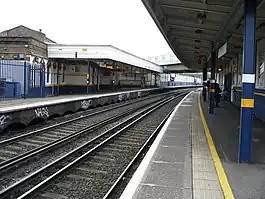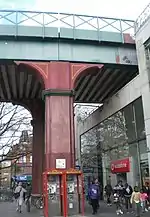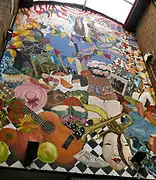Brixton railway station
Brixton railway station is a commuter railway station in Brixton, South London, UK. It is on the Chatham Main Line, 3 miles 14 chains (5.1 km) down the line from London Victoria. Trains are operated by Southeastern. The typical service is one train every 15 minutes in both directions, from Victoria to Orpington via Bromley South.
| Brixton | |
|---|---|
 | |
 Brixton Location of Brixton in Greater London | |
| Location | Brixton |
| Local authority | London Borough of Lambeth |
| Managed by | Southeastern |
| Station code | BRX |
| DfT category | E |
| Number of platforms | 2 |
| Fare zone | 2 |
| OSI | Brixton |
| National Rail annual entry and exit | |
| 2017–18 | |
| 2018–19 | |
| 2019–20 | |
| 2020–21 | |
| 2021–22 | |
| Railway companies | |
| Original company | London, Chatham and Dover Railway |
| Pre-grouping | London, Chatham and Dover Railway |
| Post-grouping | Southern Railway |
| Key dates | |
| 25 August 1862 | Opened |
| Other information | |
| External links | |
| WGS84 | 51.4629°N 0.1132°W |
It is about 110 yards (100 m) north of Brixton Underground station, high above ground level on a railway bridge that can be seen from the tube station. Access is from Atlantic Road via staircases. It is also a busy junction, with the Catford Loop via Peckham Rye and Bellingham leaving the Chatham Main Line immediately west of the station, though there are currently only platforms on the Chatham Main Line. The South London line crosses above the east end of the platforms, without stopping nearby.
History
_1910233.jpg.webp)
Brixton was opened as Brixton and South Stockwell in 1862 by the London, Chatham and Dover Railway (LC&DR) to serve the affluent Victorian suburbs of South London.[3] Services ran from Moorgate to London Victoria via Snow Hill (Holborn Viaduct), Camberwell New Road and Brixton and South Stockwell to Grosvenor Road, following the opening of the link northeastwards to London Blackfriars via Loughborough Junction in 1864.[4] The station was also connected to the LC&DR's branch to Crystal Palace High Level via Nunhead soon afterwards, with this section (via Denmark Hill) becoming part of the modern-day Catford Loop Line.
The station is currently served only by trains on the main line towards Herne Hill. The Denmark Hill line platforms were closed in April 1916 as a wartime economy measure and have been demolished except for a short section of the up platform. However, the line itself remains in regular and frequent use by both freight and passenger services.
Services
All services at Brixton are operated by Southeastern using Class 465 and 466 EMUs.
The typical off-peak service in trains per hour is:[5]
- 2 tph to London Victoria
- 2 tph to Orpington via Bromley South
During the peak hours, the station is served by an additional half-hourly service between London Victoria and Orpington, increasing the service to 4 tph in each direction.
| Preceding station | Following station | |||
|---|---|---|---|---|
| Southeastern | ||||
| Historical railways | ||||
| Clapham High Street Line and station open |
London, Chatham & Dover Railway City Branch |
Loughborough Junction Line open, platforms closed | ||
| London, Chatham & Dover Railway |
Denmark Hill Line and station open | |||
Future Proposals


The London Overground network passes above the station without stopping. This segment of the South London Line became part of the network as the second phrase of the East London line extension project. Completed in December 2012, the extension connected the South London Line to the East and West London Lines, from Surrey Quays to Clapham Junction.[6]
The line also passes through Loughborough Junction.[6] Adding both stations to the route was excluded from the plan due to the prohibitive cost of building on the high viaducts at each location.[7] The proposals drew criticism for not including new interchange stations at these locations.[8][9] Until 1976 trains stopped at nearby East Brixton. It has been proposed that this disused station could be reopened instead as the site is close to both Brixton and Loughborough Junction.[10][11]
Artworks
A number of colourful murals have been painted on the outside of the station. Inside the station, three bronze sculptures stand on the platforms. This work, Platforms Piece by Kevin Atherton, was erected in 1986 and the statues are life casts of three people - two black, one white - who regularly travelled from Brixton.[12] The statues, believed to be the first sculptures of black British people in a public place in the UK, were given Grade II listed status in November 2016.[13]
Gallery
 Southeastern branded signs
Southeastern branded signs Woman waiting at Brixton
Woman waiting at Brixton Her male counterpart
Her male counterpart The Mural
The Mural North entrance, cáfe closed
North entrance, cáfe closed Networkers work the local trains.
Networkers work the local trains. Disused platform linking to the Catford Loop Line, with third statue
Disused platform linking to the Catford Loop Line, with third statue A 1908 Railway Clearing House map of lines through Brixton
A 1908 Railway Clearing House map of lines through Brixton
Connections
LC&DR's Metropolitan Extensions and neighbouring railway lines | ||||||||||||||||||||||||||||||||||||||||||||||||||||||||||||||||||||||||||||||||||||||||||||||||||||||||||||||||||||||||||||||||||||||||||||||||||||||||||||||||||||||||||||||||||||||||||||||||||||||||||||||||
|---|---|---|---|---|---|---|---|---|---|---|---|---|---|---|---|---|---|---|---|---|---|---|---|---|---|---|---|---|---|---|---|---|---|---|---|---|---|---|---|---|---|---|---|---|---|---|---|---|---|---|---|---|---|---|---|---|---|---|---|---|---|---|---|---|---|---|---|---|---|---|---|---|---|---|---|---|---|---|---|---|---|---|---|---|---|---|---|---|---|---|---|---|---|---|---|---|---|---|---|---|---|---|---|---|---|---|---|---|---|---|---|---|---|---|---|---|---|---|---|---|---|---|---|---|---|---|---|---|---|---|---|---|---|---|---|---|---|---|---|---|---|---|---|---|---|---|---|---|---|---|---|---|---|---|---|---|---|---|---|---|---|---|---|---|---|---|---|---|---|---|---|---|---|---|---|---|---|---|---|---|---|---|---|---|---|---|---|---|---|---|---|---|---|---|---|---|---|---|---|---|---|---|---|---|---|---|---|---|
| ||||||||||||||||||||||||||||||||||||||||||||||||||||||||||||||||||||||||||||||||||||||||||||||||||||||||||||||||||||||||||||||||||||||||||||||||||||||||||||||||||||||||||||||||||||||||||||||||||||||||||||||||
London Buses routes 2, 3, 35, 37 (at Lambeth Town Hall); 45, 59, 109, 118, 133, 159, 196, 250, 322, 333, 345 (at Brixton Police Station), 355, 415, 432, 689, 690, P4, P5 and night routes N2, N3, N35, N109 and N133 serve the station.
See also
- Murder of Deborah Linsley – unsolved 1988 murder of a woman that occurred on a train travelling between Brixton and London Victoria
References
- "Out-of-Station Interchanges" (Microsoft Excel). Transport for London. 2 January 2016. Retrieved 28 August 2016.
- "Estimates of station usage". Rail statistics. Office of Rail Regulation. Please note: Some methodology may vary year on year.
- "Stockwell history". London Borough of Lambeth. Archived from the original on 24 October 2009. Retrieved 4 August 2009.
- Herbert, Henry (1877). Herbert's Metropolitan Hand-Book. Henry Herbert & Co. p. 73. ISBN 978-1-103-01106-3.
- Table 195 National Rail timetable, December 2022
- Transport for London (2006). "The Tube in 2010". Retrieved 3 November 2007. (map illustrating future development phases as proposed by TfL in 2006, subject to change)
- "East London Line Extensions - Loughborough Junction". AlwaysTouchOut. 9 November 2006. Retrieved 3 November 2007.
- "Junction joy South". South London Press (archived). 24 April 2004. Archived from the original on 9 May 2004. Retrieved 3 November 2009.
- Martin Linton MP (4 August 2006). "Parliamentary Debate: London Orbital Rail Network". Hansard. Retrieved 3 November 2007.
- "Connecting Brixton to the London Overground. Petition launched to reopen East Brixton station". Brixton Buzz. 18 February 2014. Retrieved 24 October 2018.
- Cobb, Jason (21 March 2017). "Lambeth Council starts review to look at business case for reopening East Brixton train station". Brixton Buzz. Retrieved 24 October 2018.
- Miles, Malcolm (1997). Art, space and the city. Routledge. p. 47. ISBN 978-0-415-13943-4.
- Brown, Mark (3 November 2016). "First UK public statues of black British people given listed status". The Guardian. ISSN 0261-3077.
External links
- Train times and station information for Brixton railway station from National Rail